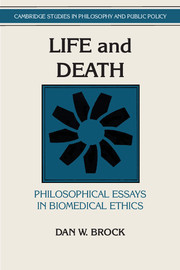Book contents
- Frontmatter
- Contents
- Sources and acknowledgments
- Introduction
- PART I PHYSICIANS AND PATIENTS MAKING TREATMENT DECISIONS
- 1 Informed consent
- 2 The ideal of shared decision making between physicians and patients
- 3 When competent patients make irrational choices
- PART II LIFE-AND-DEATH DECISIONS IN THE CLINIC
- PART III LIFE-AND-DEATH DECISIONS IN HEALTH POLICY
- Index
2 - The ideal of shared decision making between physicians and patients
Published online by Cambridge University Press: 05 June 2012
- Frontmatter
- Contents
- Sources and acknowledgments
- Introduction
- PART I PHYSICIANS AND PATIENTS MAKING TREATMENT DECISIONS
- 1 Informed consent
- 2 The ideal of shared decision making between physicians and patients
- 3 When competent patients make irrational choices
- PART II LIFE-AND-DEATH DECISIONS IN THE CLINIC
- PART III LIFE-AND-DEATH DECISIONS IN HEALTH POLICY
- Index
Summary
INTRODUCTION
Shared treatment decision making, with its division of labor between physician and patient, is a common ideal in medical ethics for the physician-patient relationship. Most simply put, the physician's role is to use his or her training, knowledge, and experience to provide the patient with facts about the diagnosis and about the prognoses without treatment and with alternative treatments. The patient's role in this division of labor is to provide the values – his or her own conception of the good – with which to evaluate these alternatives, and to select the one that is best for himself or herself. As a rough guide to practice, this is a reasonable conception; most of the time it is likely to produce sound treatment decisions. However, as an ideal it is too simplistic, and is subject to several challenges that I will explore in this essay.
Some challenges relate to the physician's role. This facts/values division of labor seems to assume that the physician can and should provide the facts about treatment alternatives in a value-neutral form. But some have questioned whether the sciences on which medicine is based are, or can be, value-free. Moreover, the concepts of health and disease, and of the normal and pathological, are held by many to be value-laden.
- Type
- Chapter
- Information
- Life and DeathPhilosophical Essays in Biomedical Ethics, pp. 55 - 79Publisher: Cambridge University PressPrint publication year: 1993
- 1
- Cited by



